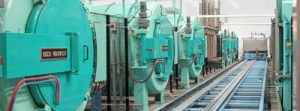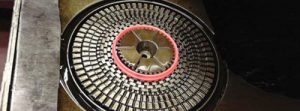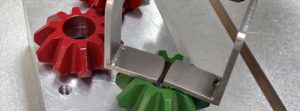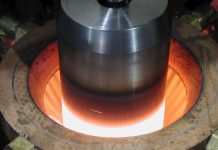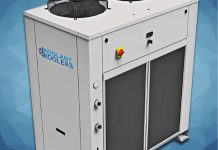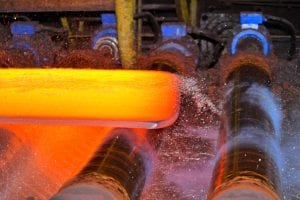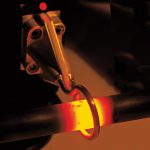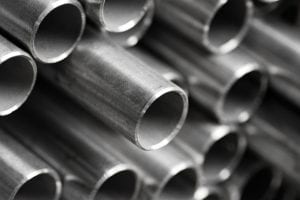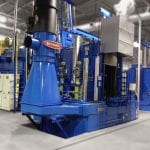Furnaces, by their very nature, use volatile materials and processes in order to improve the quality and durability of the products run through them.
When problems arise that can have an impact on this extreme high-temperature performance, it can affect a company’s bottom line at best, and can cause potential harm to worker safety at worst.
If a problem begins to exist, sensors in the furnace detect it and shut the system down. Azbil has provided a solution for this vital function for decades.
“Flame safeguard focuses on the safe startup and the safe shutdown of various types of combustion equipment and processes,” said Gavin DeFreese, vice president of revenue operations for Azbil North America. “When you’re looking at a burner or a boiler or whatever, you’ve got fuel; you’ve got fire, and you’ve got air and other gas going into it. That’s an explosive mix that needs to be closely monitored and controlled to ensure everything happens in the right sequence. The burner controllers, along with the flame sensors, ensure that, if you look at a typical furnace starting up, from the purging of the furnace, igniting the burners, and verifying the flame’s presence before allowing the main blower to start.”
Safety timing, limits, and pressure switches also play critical roles in this process, according to DeFreese.
“If that sensor does not see a flame, then it shuts everything down,” he said. “The gas valves go off; the air turns off, everything basically goes back, and it blows out again. If everything’s working right, it sees a pilot flame and the correct sequence of events, then the process moves forward. Throughout operation, whether it’s a batch process or a continuous process, we’re monitoring and making sure it’s not going to be an unsafe environment and that it goes through the proper steps to make sure it automatically shuts down.”
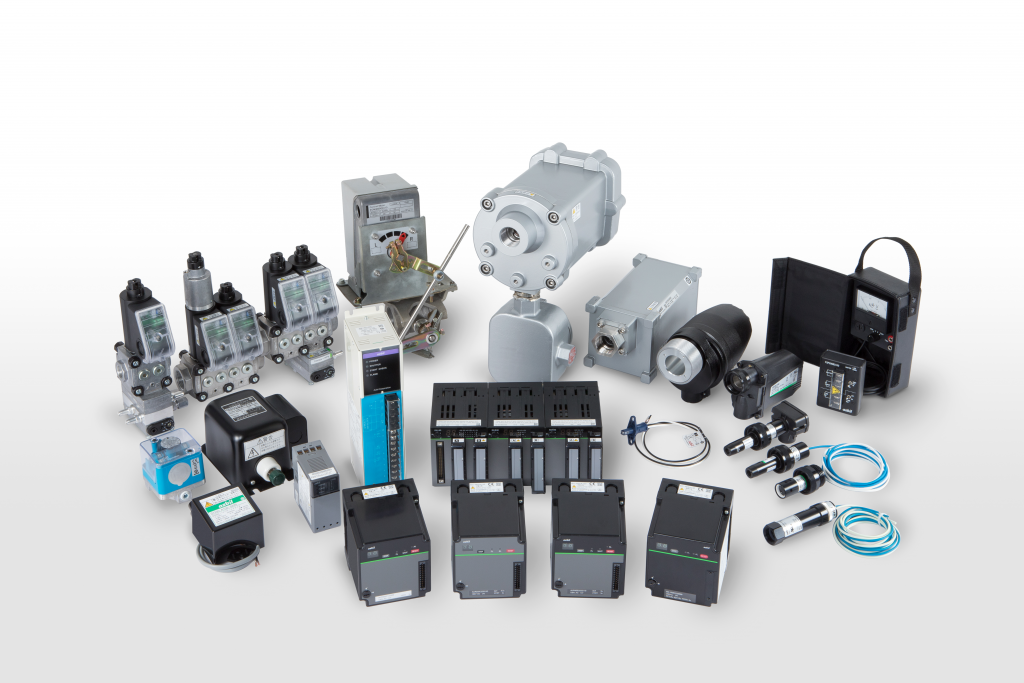
Critical process
This process becomes really critical to a plant, according to DeFreese.
“These things, while nothing is foolproof, are designed to fail-safe, and people forget about them until their furnaces and their heat-treating process actually stops in mid-environment,” he said. “They’re like, ‘What’s going on?’ With heat-treating, if you stop in the middle of a process, you’ve basically lost everything. These things are absolutely never thought of — until they are. Normally it’s product loss; it’s not a life and limb issue, but should be treated to keep all furnace operations safe.”
Most of what azbil offers to the heat-treat industry is product based, according to DeFreese, specializing in flame safeguard systems. The products include burner controllers, flame detectors, gas shutoff valves, proportional control valves, ignition transformers, igniters, pressure switches, and, on a more global aspect, seismometers and seismic sensors.
“The flame detectors have always been a real focus for azbil, as well as the burner controllers,” he said. “While no longer affiliated with other manufacturers in the U.S., many of our products are readily recognizable by most customers because of over a half century of market presence through these relationships.”

U.S. expansion
Azbil North America is headquartered in Phoenix, Arizona, and was established in 1996.
“We’re transitioning now from mainly serving our installed base to more of a growth mindset and looking for partners; we’re looking for channels and OEMs; we’re looking for end users to share our knowledge and products,” he said. “We’re putting a lot of investment into North America, including bringing in design and product engineers. In particular, we are really excited about having Satoshi Kadoya here in-house at our Ohio office. He is one of our original design engineers of the flame safety sensors with decades of experience and know-how.”
Products and the people
DeFreese said azbil is serious about making sure its customers have the best possible flame safeguard products, but also how the people are using them in the plant.
“There are not a lot of people who understand these things anymore,” he said. “Our mission is to make sure that, one, people do understand the importance of these products, but two, is to protect those who do not and who are using and are reliant on combustion equipment for their process and operations.”
One of the more fascinating aspects of azbil’s sensor technology is that, outwardly, it has remained unchanged and may look fairly simple, but the technology inside has greatly improved over the years, according to DeFreese.
“I like comparing the flame sensors and other safeguard products to car tire technology,” he said. “It is one of the most important things on a car. And to be honest, a tire looks about the same now as when I was 13 years old. But the technology, advanced materials, tread designs, and sensors for improved performance, safety, and fuel efficiency that go into them are very different. It’s the same with the flame safety products. Everyone may look at them and say, ‘Well, nothing’s changed.’ But they have become much more reliable and efficient. The sensors have become longer lasting, much more effective, a lot less problematic by providing a constant, reliable flame signal. And the manufacturing process has been improved to create the highest quality possible. It really is impressive, their reliability, performance, cost — every aspect of it.”
Industry standards
Hitoshi Ueda, Azbil North America’s director for business development and special projects, elaborated even more on what how azbil’s products have continued to evolve.
“Spec-wise, there is no great variance from our competition because it’s set by the industry,” he said. “Our standard in combustion safety originally came from the U.S.; it is what we implemented in Japan. We have made improvements, but the fundamental function of what these products need to do is essentially the same. You will not see radical departures from this form and function; it is a mature market. How we improve these things in the sense of involvement is making sure that quality is better — for example, old-style ultraviolet sensors vs. our new sensors. The differences can be subtle but substantive, like more endurance to the heat being generated from the furnace that is reflected on these products.”
Essentially it comes down to the attention to detail when honing a product, according to Ueda.
“It may be a Japanese thing, but we pay attention to small things — really, really small things,” he said. “We like to improve those things — whether it’s temperature endurance, hours in operation, things like that. We are really meticulous about these things. And some people from the end-user side may not notice because all they want are no shutdowns. As long as their furnace is up and running and they’re able to produce, it’s OK, and that’s where most of the consciousness level is — same in the U.S., same in Japan, probably the same everywhere. The producers and operators, they like to keep what they have and keep operating, because that’s how they succeed in business.”
Workforce issues
The technology offered by azbil is becoming a hot topic because of workforce issues being faced globally. The setup and maintenance of combustion systems is normally performed by seasoned workers with decades of experience. As the workforce ages out, that expertise is also fading with very few young workers filling the vacancies. Azbil’s products provide the much-needed safeguard and the Azbil North America team is looking to provide better training for those products help to fill this growing experience void, according to Ueda.
“A guy used to come in and look at the burner, look at the color, he would sense something, and he would know something was wrong,” he said. “Nowadays, it’s hard to get younger workers into these environments, but when they do come in, then what happens? How do we educate the people? That’s when we get involved, teaching these people. We do that, and we provide more tools to accurately sense the preventative maintenance times. These are the things that I think will keep us moving forward: More human-centered because the fundamentals of the product specs will not change. It’s a safety thing; it’s regulated.”
Decades of experience
Before it was known as azbil, the company started in Japan as Yamatake Shokai Co., Ltd. in 1906. After an equity-based alliance with Honeywell Inc. in 1953, it eventually became Yamatake-Honeywell. The relationship ended in 2002 but is one of the reasons many in North America immediately recognize the products. The original founder, Yamaguchi Takehiko, instilled in the company a philosophy that, according to DeFreese, is still relevant today: His aim to “free people from drudgery” has evolved into the azbil Group’s philosophy of “human-centered automation.”
CSR efforts and contributions to the environment
In 2008, Yamatake Corporation changed the group name to azbil Group, and as a world-class comprehensive automation manufacturer, has strived to contribute to a human-centered economy, environment, and to achieve the sustainable development of its customers and society. DeFreese said that the azbil Group leverages the knowledge and expertise developed at customers’ sites in Japan and oversea, to provide unique value-added services that help customers reduce their environmental impact but also supports group company and individual efforts.
In February of this year, supported by Azbil North America’s sustainable goals group, he and Ueda trained for and completed a 100K desert race to raise money for the National Multiple Sclerosis Society.
Traditional furnaces still the norm
As Azbil continues to offer its efficient burner sensors to a growing market, Ueda said that, even though electric furnaces are making up a part of the sector, traditional furnaces aren’t going anywhere any time soon.
“With certain equipment, combustion heating makes more sense than electric,” he said. “Whether it is the volume of BTUs, cost of changing legacy systems, or overall cost and efficiency. I think that at least in my lifetime, it is not going to change.”
That also means paying attention to the customers’ needs, wherever they may be, according to Ueda.
“We are going to try to focus on the field, sticking to the old rule — you hear something; you go visit; you talk to the customer; you identify what the problem is, and you work together,” he said. “Some people may not want to invest, and they may have a different timeframe than you, but you just work with these people and move on one by one. It is never a quick thing, but we want to earn a trust and gain a working relationship with each one. It’s a slow process, but there are no shortcuts. That’s why we are here, and proud to be old school with new ideas.”
Old school vs. new tech
DeFreese also pointed out an odd combination of factors that will also be part of the current heat-treating world.
“Especially with new technology, in the industrial world, you have this weird mix of 50-year-old technology and new opportunities with AI,” he said. “That’s one of the biggest challenges coming up in the next few years is that there are some physical safety-based systems that you will never get away from or shouldn’t get away from. Sure, the information coming from these should be aggregated and used for analysis. We know how to achieve safe and stable operation and optimized maintenance through state-of-the-art technology but when it comes down to it, this is very situational based — if you have a problem, you shut down fast and safely. No compromising.”
More info: us.azbil.com







